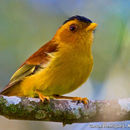en
names in breadcrumbs


The black-capped piprites (Piprites pileata), also known as the black-capped manakin, is a species of suboscine passerine. It has traditionally been placed in the Tyrannidae.
It is found in Atlantic forest, especially with Araucaria angustifolia, growing in highlands of south-eastern Brazil and north-eastern Argentina (Misiones only). Until the recent rediscovery in Argentina, the only confirmed record for that country was a specimen taken in 1959. It is generally rare and local, and therefore considered vulnerable by BirdLife International. It is known from a number of protected areas, including the Itatiaia National Park in Rio de Janeiro, and Campos do Jordão State Park in São Paulo.
The black-capped piprites (Piprites pileata), also known as the black-capped manakin, is a species of suboscine passerine. It has traditionally been placed in the Tyrannidae.
It is found in Atlantic forest, especially with Araucaria angustifolia, growing in highlands of south-eastern Brazil and north-eastern Argentina (Misiones only). Until the recent rediscovery in Argentina, the only confirmed record for that country was a specimen taken in 1959. It is generally rare and local, and therefore considered vulnerable by BirdLife International. It is known from a number of protected areas, including the Itatiaia National Park in Rio de Janeiro, and Campos do Jordão State Park in São Paulo.
 Piprites pileata; illustration 1838
Piprites pileata; illustration 1838